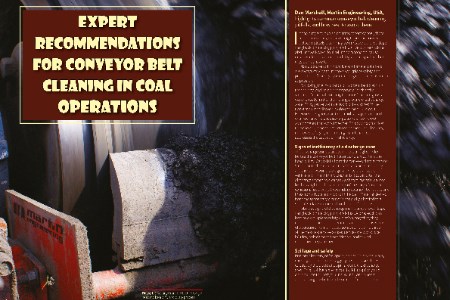Expert Recommendations For Conveyor Belt Cleaning In Coal Operations
Published by Jess Watts,
Editorial Assistant
World Coal,

In the dirty and punishing atmosphere of coal, there are no absolutes, so expecting to get the conveyor belt completely clean may be unreasonable. Spillage, carryback, chute clogging, and fugitive dust emissions obstruct walkways, foul rolling components, cause unscheduled downtime, and degrade air quality... but they do not have to.
Manufacturers of innovative equipment solutions are always striving to improve workplace safety and production efficiency by eliminating the causes as much as possible.
Following the installation of modern belt cleaning technology, coal mine operators realise that the volume of material entering the transfer chute grows exponentially, rather than piling around the discharge zone. This greater volume leads to blockages in the transfer chute followed by downtime to unclog it. However, designers can take a holistic approach and engineer an efficient discharge transfer point with components that work together. This approach strives to make equipment last between scheduled closures, improves safety by minimising maintenance, and addresses the causes of inefficiency.
Signs of inefficiency at a discharge zone
The discharge zone starts at the last troughed idler before the conveyor belt flattens and encounters the head pulley. Cargo falls from the conveyor into a transfer ‘drop’ chute that can lead to several places, including another conveyor, a storage silo/pile, a transport vehicle, etc. The primary cleaner is located after the discharge stream to clear any adhered material caused by the weight or characteristics of the cargo (moisture, cohesion, heat, etc.). A secondary cleaner clears dust and fines from divots and cracks in the belt. Material cleared from the secondary cleaner is generally directed to a sloped surface connected to the transfer chute.
Obvious signs of discharge inefficiency are spillage, carryback, chute clogging, and dust. Alone, each can lead to a workplace safety violation; together, they result in unscheduled downtime and an increased cost of operation. From an operational standpoint, three of the most expensive consequences are workplace injuries, belt damage from friction, and fouled equipment replacement.
Spillage and safety
Primary cleaners, or ‘scrapers’, can fail in several ways, causing adhered coarse aggregate and caked fines to pass by the blade and spill around the discharge area. This fugitive material can build up quickly and encapsulate the belt, fouling rolling components and causing the belt to ride on top of the course pile, leading to serious belt damage and increased belt temperatures from friction.
Fugitive material spills into walkways, obstructs access for maintenance and creates a trip and fall hazard. When course grit fouls rollers it causes them to freeze, leading to friction and high-heat damage to the vulnerable return side of the belt, lowering the equipment’s life. To avoid belt fires and dust explosions, seized idlers/rollers should be maintained and changed right away, which makes clear access to the system imperative.
Cleaning spillage can be costly, divert staff from other essential duties, and become a workplace safety issue if workers are clearing material around a running belt (see Figure 3). What may seem like a routine job in the beginning, clearing spillage by either shoveling it back into the cargo stream or into bins, requires more labour as time goes on and the problem worsens. Clearing material using machinery (front loaders, industrial vacuums, etc.) can result in accidental contact with the stringer or supports, potentially leading to belt mistracking.
Mistracking can be a major cause of spillage, not just along the belt path, but at the discharge point as well. The blade is centred on the head pulley, but if the belt is not, adhered material becomes spillage.
Recommendation:
Install a belt tracker a distance of three to four times the width of the belt prior to the head pulley, as the trough angle flattens to ensure the belt hits the head pulley in the centre.
This is a preview of an article that was originally published in Issue 1 of World Coal 2025.
Subscribe to World Coal for free to read this article in full and many more here.
Read the article online at: https://www.worldcoal.com/coal/30072025/expert-recommendations-for-conveyor-belt-cleaning-in-coal-operations/
You might also like
Blackout legacy: Reusing coal mine transformers for resilient rural power
The adaptive reuse of transformers from decommissioned coal mines delivers a viable solution for enhancing rural grid stability. According to Jane Marsh, Editor-in-Chief at Environment.co, this approach entails honouring industrial legacies while creating a more robust, diversified energy landscape.


